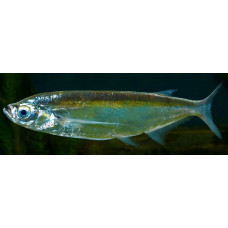Pelecus cultratus is a fish of the genus Pelecus, family Cyprinidae. It is up to 60 cm long and weighs 0.5-0.6 kg. It inhabits brackish and fresh waters of the Baltic, Black, Azov, Aral and Caspian Sea basins. Semi-dormant and dormant forms. Leads a gregarious pelagic life. Breeds in the third to fourth year of life. Fecundity is 10-58 thousand eggs. Pelagophile. Feeds on zooplankton, aerial insects and juvenile fish. Of commercial importance.
The body is long and slender, compressed at the sides, sabre shaped. The dorsal colouration is greyish-green to greenish-blue, the sides are silvery, the belly is pale with a pink spot. The dorsal fin is grey, above the anal fin. It has 2-3 hard and 6-8 soft rays. The anal fin has 2-3 hard and 24-29 soft rays. The caudal fin is also grey, forked. The rest of the fins are yellowish. The mouth is upper, rather large. The lateral line runs close to the belly in a zigzag pattern. There is a keel on the belly, which is not covered with scales.
Pelecus cultratus is easily distinguished from other carp by the shape of its elongated and very flattened body; the back is almost perfectly straight, the belly is very convex and sharp, and the whole fish bears a strong resemblance to a short sabre.
Inhabits the basins of the Caspian, Black, Azov and Baltic Seas. It used to live in the Aral Sea. Prefers large rivers and reservoirs not overgrown with algae, and large lakes, e.g. Ladoga, Aidarkul in Uzbekistan, middle and lower Volga. It spends the day in shallow water or near the surface, and at night it descends to greater depths. With the onset of cold weather, it descends into holes and pools. In autumn and spring there is a mass movement of this fish in the rivers. Pelecus cultratus feeds mainly on insects and their larvae, worms and young fish.
Pelecus cultratus loves the great outdoors and lives mainly in large rivers and inland seas, less often in large lakes and almost never in small rivers. In autumn and spring it makes very large migrations up and down the rivers, when it gathers in large herds and is caught in large numbers. Usually it lives in the deepest and fastest places of the river and in the widest branches, in summer also in black and sea bays and never enters poyemnye places, flood lakes and ilmen. It swims very fast and often jumps out of the water, chasing insects and small fish, which are often found in its stomach. Most often it gets into the prey of small bleak and the young of some other fish, but the main food of Chekhoni still make various worms and insects. Its life expectancy is insignificant, but it lives at least ten years. It appears to become fertile before the age of two, as it grows extremely fast.
Pelecus cultratus spawns from early May to mid-June at water temperatures of +12...+15°C and above. Fecundity ranges from 10,000 to 300,000 eggs. The diameter of the eggs is 3,8-5,9 mm.
Pelecus cultratus
Tags: pelecus cultratus



